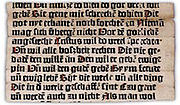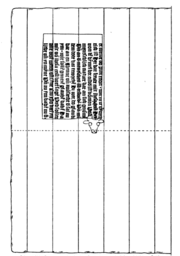
Sibyllenbuch fragment
Encyclopedia

Gutenberg Bible
The Gutenberg Bible was the first major book printed with a movable type printing press, and marked the start of the "Gutenberg Revolution" and the age of the printed book. Widely praised for its high aesthetic and artistic qualities, the book has an iconic status...
, which was printed c. 1454. The Sibyllenbuch ("Book of the Sibyls") is a medieval poem containing prophecies of the fate of the Holy Roman Empire
Holy Roman Empire
The Holy Roman Empire was a realm that existed from 962 to 1806 in Central Europe.It was ruled by the Holy Roman Emperor. Its character changed during the Middle Ages and the Early Modern period, when the power of the emperor gradually weakened in favour of the princes...
. The British Library
British Library
The British Library is the national library of the United Kingdom, and is the world's largest library in terms of total number of items. The library is a major research library, holding over 150 million items from every country in the world, in virtually all known languages and in many formats,...
’s on-line Incunabula Short Title Catalogue
Incunabula Short Title Catalogue
The Incunabula Short Title Catalogue is an electronic bibliographic database maintained by the British Library which seeks to catalogue all known incunabula. The database lists books by individual editions, recording standard bibliographic details for each edition as well as giving a brief census...
dates the Sibyllenbuch fragment to "about 1452-53", making it older than any other European printed work. (Various movable type systems were developed in East Asia as early as the Eleventh Century
History of typography in East Asia
The history of printing in East Asia refers to the use of woodblock printing and movable type printing by East Asian artisans. The former existed in Tang China as early as the 7th century, and the latter in Song China by the 11th century. Use of woodblock printing quickly spread to other East Asian...
.)
Fragment and its text

German language
German is a West Germanic language, related to and classified alongside English and Dutch. With an estimated 90 – 98 million native speakers, German is one of the world's major languages and is the most widely-spoken first language in the European Union....
using Gothic letter
Blackletter
Blackletter, also known as Gothic script, Gothic minuscule, or Textura, was a script used throughout Western Europe from approximately 1150 to well into the 17th century. It continued to be used for the German language until the 20th century. Fraktur is a notable script of this type, and sometimes...
. It is owned by the Gutenberg Museum
Gutenberg Museum
The Gutenberg Museum is one of the oldest museums of printing in the world, located opposite the cathedral in the old part of Mainz, Germany. It is named after Johann Gutenberg, the inventor of printing from moveable metal type...
in Mainz
Mainz
Mainz under the Holy Roman Empire, and previously was a Roman fort city which commanded the west bank of the Rhine and formed part of the northernmost frontier of the Roman Empire...
, Germany. The fragment was discovered in 1892 in an old bookbinding in Mainz. The text on the fragment relates to the Last Judgment
Last Judgment
The Last Judgment, Final Judgment, Day of Judgment, Judgment Day, or The Day of the Lord in Christian theology, is the final and eternal judgment by God of every nation. The concept is found in all the Canonical gospels, particularly the Gospel of Matthew. It will purportedly take place after the...
and therefore sometimes is also called “Das Weltgericht” (German for "Last Judgment"). The text is part of a fourteenth century poem of 1040 lines known as the "Sibyllenbuch" (Book of the Sibyls
Sibyl
The word Sibyl comes from the Greek word σίβυλλα sibylla, meaning prophetess. The earliest oracular seeresses known as the sibyls of antiquity, "who admittedly are known only through legend" prophesied at certain holy sites, under the divine influence of a deity, originally— at Delphi and...
) containing "prophecies concerning the fate of the Holy Roman Empire". The British Library identifies the fragment as coming from a quarto
Quarto
Quarto could refer to:* Quarto, a size or format of a book in which four leaves of a book are created from a standard size sheet of paper* For specific information about quarto texts of William Shakespeare's works, see:...
volume, which is a book composed of sheets of paper on which four pages were printed on each side, which were then folded twice to form groups of four leaves or eight pages. From analysis of the location of the watermark
Watermark
A watermark is a recognizable image or pattern in paper that appears as various shades of lightness/darkness when viewed by transmitted light , caused by thickness or density variations in the paper...
on the fragment and the known length of the entire poem, it has been estimated that the complete work contained 37 leaves (74 pages) with 28 lines per page.
Type face and date
The type face used in the Sibyllenbuch is the same as that used in other early fragments attributed to Johannes Gutenberg, an Ars minor by DonatusAelius Donatus
Aelius Donatus was a Roman grammarian and teacher of rhetoric. The only fact known regarding his life is that he was the tutor of St...
(a Latin grammar used for centuries in schools) and several leaves of a pamphlet called the Turkish Calendar for 1455 (likely printed in late 1454), and has been called the DK type after its use in the Donatus and Kalendar. Scholars have identified several different states of this type face, a later version of which was used in about 1459-60 to print the so-called 36-line Bible
36-line Bible
The 36-line Bible, also known as the "Bamberg Bible" and sometimes called a "Gutenberg Bible", is the second printed edition of the Bible, after the Gutenberg Bible. It is believed to have been printed in Bamberg, Germany, about 1458-60...
. For this reason, the various states of this type have collectively been called the “36-line Bible type.”
Due to the “less finished state of the [DK] font”, scholars have concluded it was “plausibly earlier than 1454", the approximate date of the publication of Gutenberg’s Bible. Although at one time some believed it dated to the 1440s, it is now believed to have been printed in the early 1450s. George D. Painter concluded that “primitive imperfection” in the type face of the Sibyllenbuch indicated it was the earliest of the fragments printed in the DK type. The British Library
British Library
The British Library is the national library of the United Kingdom, and is the world's largest library in terms of total number of items. The library is a major research library, holding over 150 million items from every country in the world, in virtually all known languages and in many formats,...
’s on-line Incunabula Short Title Catalogue
Incunabula Short Title Catalogue
The Incunabula Short Title Catalogue is an electronic bibliographic database maintained by the British Library which seeks to catalogue all known incunabula. The database lists books by individual editions, recording standard bibliographic details for each edition as well as giving a brief census...
dates the Sibyllenbuch fragment to 1452-53, which, if correct, would make it the earliest surviving example of any European printing using movable type.
Ink
A cyclotronCyclotron
In technology, a cyclotron is a type of particle accelerator. In physics, the cyclotron frequency or gyrofrequency is the frequency of a charged particle moving perpendicularly to the direction of a uniform magnetic field, i.e. a magnetic field of constant magnitude and direction...
analysis, conducted by the Crocker Nuclear Laboratory at the University of California at Davis in 1987, confirmed that the ink on the Sibyllenbuch has high levels of lead and copper, closely similar to that used for other works printed by Gutenberg.
Sources
- British Library, Incunabula Short Title Catalogue, entry for the Sibyllenbuch.
- Entry for Bulla Thurcorum (1456) on the Princeton University on line digital collections
- Margaret Bingham Stillwell, The Beginning of the World of Books, 1450 to 1470, Bibliographical Society of America, New York, 1972.

